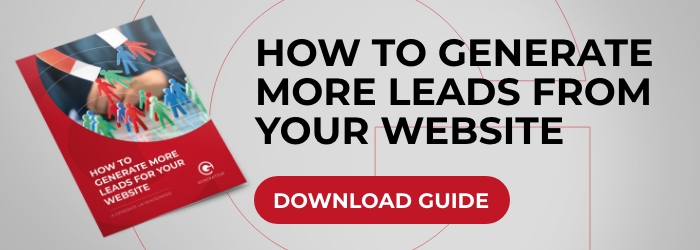A beginner’s guide to lead generation
Learn more about lead generation strategies and how you can implement them into your marketing.

Lead generation doesn’t have to be all cold calling and spam emails to potential customers…
In fact, there are many smarter, less invasive marketing methods you can use to generate leads.
To help you and your company out we have created this beginner’s guide as a reference to support your future lead generation strategies and campaigns.
What is a lead?
A lead is simply a person or group of people who express an interest in a company’s product or service.
This could be indicated by a user contacting the company, or something smaller and less obvious such as opening a marketing email and clicking onto the website.
There are several different types of lead, and these are usually broken up into two categories: warm and cold.

Cold leads
We have all had experience of a company calling us and trying to sell their products. You may not have even engaged with them previously or you may have signed up to a mailing list for a sister company of theirs.
Either way, this is called a cold lead.
These are difficult to convert as they often have no brand loyalty or knowledge of the company from which you are calling.
You will also find more resistance from those customers as the call/email/ message has come out of nowhere and may occur when they are busy. This will create a large degree of hesitancy from the recipient, and we always recommend against this if you can help it.
Warm leads
For a lead to be classed as warm, the customer/user would have needed to engage in some way with the company. This could be either signing up to their mailing list, visiting their website or clicking on one of their emails.
A warm lead is when the potential customer has expressed some sign of interest in the product or service.
These are easier to convert into sales as the user will have some knowledge of your company/product/service and you may find it is easier to engage them in a conversation.
However, once we split them down into warm and cold leads, it doesn’t stop there. We then have different levels of leads based on which part of the sales process the consumer joined.
There are four main lead types in any company, these are:
- Marketing qualified leads
- Sales qualified leads
- Product qualified leads
- Service qualified leads
How to classify leads

Marketing qualified leads
These leads are accrued during your company’s marketing efforts but may not be ready for a sales call just yet.
These leads could occur from a user clicking onto a landing page or filling in an online form relating to an offer or newsletter from a recent marketing campaign.
Sales qualified leads
A sales qualified lead is a user who has expressed more interest in your company and particularly in using your services/ buying your products.
These types of leads are much easier to convert into sales. An example of a sales qualified lead is if a user fills in a contact form on your website asking questions specifically about a product or your services.
Product qualified leads
With a product qualified lead, these are customers who have used your product and who have since expressed an interest in paying for this service.
This is particularly relevant to companies that offer free trials for software or services.
Service qualified leads
A service qualified lead occurs by a customer directly engages with a company’s service team and expresses an interest in paying for their services or products.
For example, the customer services team may be contacted by a user who has advised they wish to upgrade their current software package on a certain date to a fee-paying one.
As you can see, each of these leads occurs at different stages of the customer journey and will often come from different departments.
To make sure you stay on top of your lead generation and tracking, make sure that all these departments have a good level and channel of communication to stay updated on potential leads and to align your lead generation strategy.
What is lead generation?
Lead generation is the process of attracting these consumers to engage with your company and buy your product or use your services.
There are several different methods you can implement into your strategy to help gain, nurture, and convert your leads into sales.
But, it is all about warming them up, enticing them and educating them about your company.

What are the different types of lead generation tools?
When it comes to lead generation campaigns and tools, there are no set rules. Each company will be different, and it will all depend on many different factors:
- Target demographic
- Age
- Industry
- And many more….
Just like any marketing campaign, you need to use your market research about your target market to create personalised content, which will appeal to that group of users.
Consider how they usually engage with content, what their level of technology skills are and whether they use social media regularly.
Having a good grasp of who your target markets are and what they are like, will help you create effective lead generation tools. These tools could include:
- Blog posts
- Whitepapers
- Social media promotions
- Offers/discount codes
- Tailored landing pages
- Live event (online or in-person)
Basically, anything which will attract your potential consumers’ attention and make them want to find out more about your company and the products/services you offer.
These can all be transformed into useful lead generation tools.
Remember, the more tailored, and personalised your content is for your target market, the better your conversions are likely to be. This also helps to create a good user experience.

How to create an effective lead generation strategy
Before you start planning and creating your lead generation strategy there are certain questions you should ask yourself to ensure you create the best plan for your company.
These questions are:
- Who are you aiming at?
- Where do they engage and communicate most?
- How do they engage? What is their purpose on that platform?
- What is their overall goal of being on there?
All these answers will help you understand your target market, and what type of lead generation strategy will work best for your company.
It will also help you ascertain which platform or platforms will be most effective.
If you are stuck for ideas here are a few lead generation strategy ideas, we have come up with.
Gated Content
If you look on social media, especially LinkedIn you will see companies posting whitepapers and similar assets for their customers.
These are usually free content in exchange for user details such as name and email address. This is called gated content and can be a very effective lead generation strategy.
This is a great tool to use, as you are providing value for the user in the form of free advice or information, and in exchange, you have the information you can use as part of a marketing campaign to entice them to invest in your company.
This can be conducted through nurturing campaigns throughout the year, to slowly encourage them in, or you could use it for a more direct marketing approach.
This type of strategy is better than a cold call approach as the user will already have heard of your company and has expressed an interest in your business.
Landing pages
This is another great lead generation tool. We use landing pages for a variety of different purposes, from promoting a new product range to highlighting a particular asset download.
However, when creating a landing page for lead gen make sure you optimise it for conversions.
This means either adding in gated content or a data capture form for other purposes such as email newsletter sign up. Once you have created and launched your landing page for conversions, make sure you create a strategy to drive traffic to this page.
Here are our top tips for creating optimised landing pages:
- Ensure the title of the page links to the headline of your advertising
- Don’t overload the user with actions
- Create dedicated landing pages for each audience segment – each will have different needs from a page.
- Keep the page clean and easy to read
- Tell visitors exactly what they’re going to get from completing a form
- Use social proof such as testimonials or customer logos
- Be mobile friendly

Paid Ads to drive traffic
When you first create and publish a landing page it can be difficult to drive traffic to it. You can use organic social media posts, but this can be difficult to get the right exposure due to each platform’s algorithms. Especially as many platforms don’t like companies using external links in the posts and thus may decrease your reach on these posts.
One great tool to use to help drive traffic to it is paid ads.
Social paid ads are especially effective, as you can narrow down your targeting options to job sectors, job titles, age ranges etc, depending on which platform you are using.
You can even use platforms such as Facebook or LinkedIn to run remarketing campaigns, to aim your content at users who have previously expressed interest in your product or services including:
- Followers of your social media pages
- Visitors to your website in the last 30 days
- Users who have added items to their basket but didn’t check out
- Similar users to those currently on your email list or who are interested in similar topics to your gated content
If you have never used social media ads, we recommend you start small and experiment with different audiences to see which ones work for you.

Use social media ads to make form completion easier
If you are finding that users are clicking on your landing page but aren’t filling in the form, you could also try using social media ads that are specifically aimed at lead generation strategies.
Both, LinkedIn, and Facebook both have lead-gen based ad creation, whereby the user doesn’t have to fill in the form as this is usually auto-populated by the platform, which often leads to a higher form completion rate.
Through these methods, the users will be able to access your gated content directly from the social media platform, making it simpler to achieve those leads.
Online Promotional events
Over the past few years, we have seen that video has a higher engagement rate than standard copy-based content.
So, why not make use of this to help promote your landing page or asset with an online event. This could be a live stream, panel, or any other type of online event to help promote your company and the campaign.
You could even make the live event into gated content, especially if it is a webinar where you require users to register for a space.
Webinars and videos can be a fantastic way to not only help raise brand awareness but also to generate a decent number of leads.
Clear call to actions
This is a crucial step to driving traffic to your gated content/ landing page. Wherever you are advertising, whether it is Google, social media, or your website, make sure the call to action (CTA) is clear and enticing.
Rather than stating “click here to download the whitepaper” think of the benefits your users will get from this gated content, and consider using power words such as:
- Discover
- Enhance
- Learn
- Optimise
- Transform
Using these powerful words will create a bigger impact and is likely to attract more users to your content.
You could use these words in situations such as:
- Discover the benefits of lead generation and how to implement these into your strategies
- Enhance your marketing strategy with our top tips on…
- Learn how to develop your customer base with our top lead generation tips
- Optimise your marketing campaigns with our top five strategy ideas
- Transform your marketing campaigns and boost your reach and exposure…
Consider every step of the user journey from first exposure to the final form completion, and make sure the process is as smooth and simple as possible to provide a good user experience.
If you are looking for more ideas for your next lead generation strategy check out our 12 killer lead generation ideas to convert more traffic.
ABOUT GENERATE UK
Generate growth through marketing with an award-winning, full-service digital marketing agency.
Our goal is to help businesses understand the true value in digital marketing and set out to help those businesses develop and implement new technology and processes to deliver a marketing strategy in line with their goals.
Contact us today to find out how we can help you